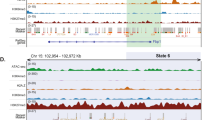Abstract
In recent years, important efforts have been made to understand how the expression of a specific gene repertoire correlates with chromatin accessibility, histone mark deposition, as well as with chromatin looping establishing connectivity with regulatory regions. The emergence of new techniques for genome-wide analyses and their progressive optimization to work on low amounts of material allows the scientific community to obtain an integrated view of transcriptional landscapes in physiology and disease. Here, we describe our own experience aiming at correlating the TCF-4/β-catenin cistrome during liver tumorigenesis with chromatin remodeling, histone mark modifications, and long-distance DNA looping.
Access this chapter
Tax calculation will be finalised at checkout
Purchases are for personal use only
Similar content being viewed by others
References
Romanoski CE, Glass CK, Stunnenberg HG et al (2015) Epigenomics: roadmap for regulation. Nature 518:314–316
Ma S, Zhang Y (2020) Profiling chromatin regulatory landscape: insights into the development of ChIP-seq and ATAC-seq. Mol Biomed 1:9
Klemm SL, Shipony Z, Greenleaf WJ (2019) Chromatin accessibility and the regulatory epigenome. Nat Rev Genet 20:207–220
Clevers H, Nusse R (2012) Wnt/beta-catenin signaling and disease. Cell 149:1192–1205
Cadigan KM, Waterman ML (2012) TCF/LEFs and Wnt signaling in the nucleus. Cold Spring Harb Perspect Biol 4:4
Mosimann C, Hausmann G, Basler K (2009) Beta-catenin hits chromatin: regulation of Wnt target gene activation. Nat Rev Mol Cell Biol 10:276–286
Valenta T, Hausmann G, Basler K (2012) The many faces and functions of beta-catenin. EMBO J 31:2714–2736
Yochum GS, Sherrick CM, Macpartlin M et al (2010) A beta-catenin/TCF-coordinated chromatin loop at MYC integrates 5′ and 3’ Wnt responsive enhancers. Proc Natl Acad Sci U S A 107:145–150
Gougelet A, Sartor C, Bachelot L et al (2016) Antitumour activity of an inhibitor of miR-34a in liver cancer with beta-catenin-mutations. Gut 65:1024–1034
Gougelet A, Sartor C, Senni N et al (2019) Hepatocellular carcinomas with mutational activation of beta-catenin require choline and can be detected by positron emission tomography. Gastroenterology 157:807
Gougelet A, Torre C, Veber P et al (2014) T-cell factor 4 and beta-catenin chromatin occupancies pattern zonal liver metabolism in mice. Hepatology 59:2344–2357
Corces MR, Trevino AE, Hamilton EG et al (2017) An improved ATAC-seq protocol reduces background and enables interrogation of frozen tissues. Nat Methods 14:959–962
Buenrostro JD, Wu B, Chang HY et al (2015) ATAC-seq: a method for assaying chromatin accessibility genome-wide. Curr Protoc Mol Biol 109:21 29 21–21 29 29. Edited by Frederick M. Ausubel ... [et al.]
Ea V, Court F, Forne T (2017) Quantitative analysis of intra-chromosomal contacts: The 3C-qPCR method. Methods Mol Biol 1589:75–88
Braem C, Recolin B, Rancourt RC et al (2008) Genomic matrix attachment region and chromosome conformation capture quantitative real time PCR assays identify novel putative regulatory elements at the imprinted Dlk1/Gtl2 locus. J Biol Chem 283:18612–18620
Corces MR, Buenrostro JD, Wu B et al (2016) Lineage-specific and single-cell chromatin accessibility charts human hematopoiesis and leukemia evolution. Nat Genet 48:1193–1203
Author information
Authors and Affiliations
Corresponding author
Editor information
Editors and Affiliations
Rights and permissions
Copyright information
© 2024 The Author(s), under exclusive license to Springer Science+Business Media, LLC, part of Springer Nature
About this protocol
Cite this protocol
Sanceau, J., Forné, T., Chantalat, S., Gougelet, A. (2024). Chromatin and DNA Dynamics in Mouse Models of Liver Cancers. In: Kroemer, G., Pol, J., Martins, I. (eds) Liver Carcinogenesis. Methods in Molecular Biology, vol 2769. Humana, New York, NY. https://doi.org/10.1007/978-1-0716-3694-7_13
Download citation
DOI: https://doi.org/10.1007/978-1-0716-3694-7_13
Published:
Publisher Name: Humana, New York, NY
Print ISBN: 978-1-0716-3693-0
Online ISBN: 978-1-0716-3694-7
eBook Packages: Springer Protocols




